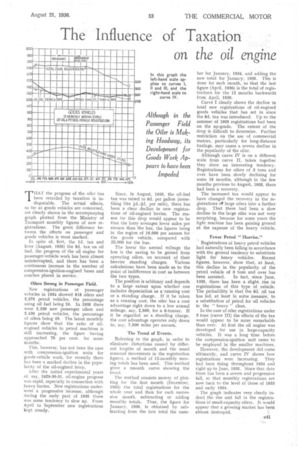The Influence of Taxation on the oil engine
Page 55

If you've noticed an error in this article please click here to report it so we can fix it.
TIIAT the progress of the oiler has I been retarded by taxation is indisputable. The actual effects, so far as goods vehicles are concerned, are clearly shown in the accompanying graph plotted from the Ministry of Transport monthly figures of new registrations. The great difference between the effects on passenger and goods vehicles is most marked.
In spite of, first, the Id. tax and later (August, 1935) the 8d. tax on oil fuel, the progress of the oil engine for passenger-vehicle, work has been almost uninterrupted, and there has been a continuous increase in the number of compression-ignition-engined buses and coaches placed in service.
Oilers Strong in Passenger Field.
New registrations of passenger vehicles in 1934 showed 818 oilers and 2,575 petrol vehicles, the percentage using oil fuel being 24. In 1935 there were 2,339 new passenger oilers and 2,430 petrol vehicles, the percentage of oilers being 49. The latest monthly figures show that the ratio of oilengined vehicles to petrol machines is still increasing, the figure • having approached 70 per cent, for some months.
This, however, has not been the case with compression-ignition units for goods-vehicle work, for recently there has been a marked decline in the popularity of the oil-engined lorry.
After the initial experimental years of say, 1929-30-31, oil-engine progress was rapid, especially in connection with heavy lorries. New registrations underwent a progressive increase, although during the early part of 1935 there was some tendency to slow up. From April to September new registrations kept steady. Since. in August, 1935, the oil-fuel tax was raised to 8d. per gallon (some
thing like per mile), there has been a clear decline in new registrations of oil-engined lorries. The reason for this drop would appear to be that the lorry averages fewer miles per annum than the bus, the figures being in the region of 16,000 per annum for the goods vehicle, compared with 33,000 for the bus.
The lower the annual mileage the less is the saving to be gained from operating oilers, on account of their heavier standing charges. Various calculations have been made as to the point of indifference in cost as between the two types.
The position is arbitrary and depends to a large extent upon whether one includes depreciation as a running cost or a standing charge. If it be taken as a running cost, the oiler has a cost advantage right down to a low annual mileage, say, 2,500, for a 6-tonner. If it be regarded as a standing charge, the cost advantage operates only down to, say, 7,500 miles per annum.
The Trend of Events, Referring to the graph, in order to eliminate distortions caused by different lengths of month and the usual seasonal movements in the registration figures, a method of 12-monthly moving totals has been used. This method gives a smooth curve showing the trend.
The method consists merely of plotting for the first month (December, 1934) the total registrations for the whole year and then for each successive month, subtracting or adding monthly totals. Thus, the figure for January, 1935, is obtained by subtracting from the first total the num
leer for January, 1934, and adding the new total for January, 1935. This is done for each month, so that the last figure (April, 1936) is the total of registrations for the 12 months backwards from April, 1936.
Curve I clearly shows the decline in total new registrations of oil-erigined goods vehicles that has set in since the 8d. tax was introduced. Up to the summer of 1935 registrations had been on the up-grade. The extent of the drop is difficult to determine. Further restriction on the use of commercial motors, particularly for long-distance haulage, may cause a severe decline in the popularity of the oiler.
Although curve IV is on a different scale from curve II, taken together they show an interesting tendency. Registrations for oilers of 3 tons and over have been slowly declining for some 18 months, although in the few months previous to August, 1935, there had been a recovery.
The increased tax would appear to have changed the recovery in the registrations of' large oilers into a further drop. That there had been a slow decline in the large oiler was not very surprising, because for some years the light machine has been gaining ground at the expense of the heavy vehicle.
Fewer Petrol "Heavies."
Registrations of heavy petrol vehicles had naturally been falling in accordance with the general tendency to substitute light for heavy vehicles. Recent figures, however, show that, at least, this decline in the popularity of the petrol vehicle of 3 tons and over has
been arrested. In fact, sinceJune, 1935, there has been a slight rise in registrations of this type of vehicle. The probability is that the 8d. oil tax has led, at least in some measure, to a substitution of petrol for oil vehicles in the " heavy " class.
In the case of oiler registrations under 3 tons (curve III) the effects of the tax would appear to be more remarkable than ever. At first the oil engine was developed for use in large-capacity vehicles. It was a long time before the compression-ignition unit came to be employed in the smaller machines.
However, the development did come ultimately, and curve IV shows how registrations were increasing. They had been rising throughout 1934 and right up to June, 1935. Since that (late there has been a severe and progressive fall, so that monthly registrations are now back to the level of those of 1933 and early 1934.
The graph indicates very clearly indeed the rise arid fall in the registrations of small-capacity oilers. It would appear that a growing market has been almost destroyed.




























































































